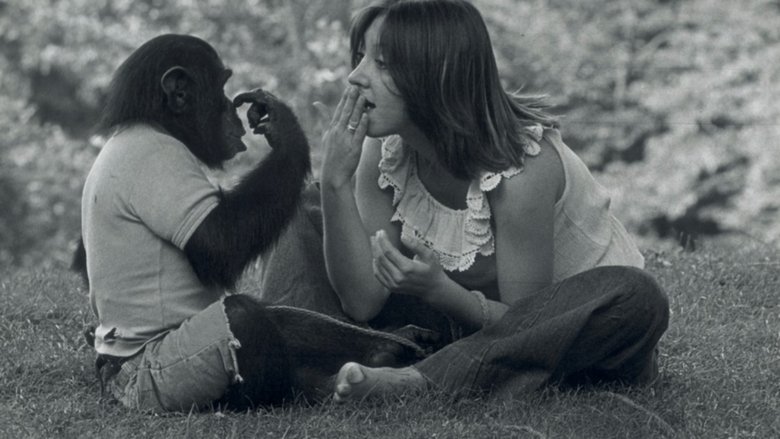

Project Nim (2011)
From the team behind Man on Wire comes the story of Nim, the chimpanzee who in the 1970s became the focus of a landmark experiment which aimed to show that an ape could learn to communicate with language if raised and nurtured like a human child. Following Nim's extraordinary journey through human society, and the enduring impact he makes on the people he meets along the way, the film is an unflinching and unsentimental biography of an animal we tried to make human. What we learn about his true nature - and indeed our own - is comic, revealing and profoundly unsettling.
Watch Trailer
Cast
Similar titles


Reviews
If you don't like this, we can't be friends.
Absolutely the worst movie.
A different way of telling a story
There are better movies of two hours length. I loved the actress'performance.
The first ten minutes of this painful documentary goes beyond any justice. The scientists involved in this corrupt and mindless experiment should be tried by a court of law for intentional cruelty and torture. If my tax dollars paid for this experiment then our government is corrupt with eyes wide shut. A Mother is systematically tortured by having 6 two week old infants chimps taken from her. The 6th being the title character. What was gained here was pure psychopathy. There was no need for this experiment except for vain exploration. This film gives every reason why science needs regulations. However, since this is not going to happen then will someone please point to the red button so I can give it a huge push. This is perhaps the most horrifying film I have ever seen. What were these scientist hoping to accomplish; to raise a chimp to be human? For what purpose? To serve humans? To be slaves? To fill a void? We have to be a mutation in the gravest form. I want these scientists prosecuted.
Where does a chimpanzee fit in the scheme of nature in relation to human beings? If you'll pardon me a crude analogy: If the evolutionary chain were a movie theater and humans occupy the front row, primates might place two rows behind us. We are a tiny fraction away from having the same DNA and when we look at them we can see that they are, basically, a savage version of what we use to be. Yet, in their eyes you can see that their thinking patterns must match ours in some fashion. What that fashion is exactly remains one of the great unsolved mysteries. What can they learn? Can they learn the way humans can? Are they communicating on our scale? Can they be taught from a young age and adapt just like a human child? These questions were the focal point of a now-legendary experiment begun in 1973 and headed by a Columbia psychology professor named Herbert Terrace to see if an infant Chimpanzee could be raised in a normal human household and could be taught to communicate. The chimp was forcibly taken from his mother mere days after birth and given the name Nim Chimpsky (we learn the heartbreaking fact that this was the sixth child that this particular mother has had taken away and we see her in silhouette mourning the loss). Nim first lived in a brownstone in Manhatten with a married couple and their children. He wore clothes, he played with the pets; his human mother let him drink beer and smoke pot (this was the early 70s). She even breast-fed him. Most importantly, he was taught functional amounts of sign language. Nim's education in sign language was at the core of the project, even though one of the family members curiously points out that no one in the family was actually fluent in sign language to begin with.The documentary Project Nim follows the progress of that experiment in reenactments and still photographs, but mostly through eyewitness testimony from the researchers who spent time working with Nim during the project. Some of the footage that we see might fit right in on a television sitcom or one of those shows from the 60s like "Daktari" or "Gentle Ben". We see little Nim rolling around on the floor playing with the kids, the dog and then the cat. It is all very cute, but one can't watch the footage and not be concerned. Nim, after all, an animal with violent tendencies.Nim, through his training, seems perfectly happy, which is ironic when you compare him with some of the humans that are caring for him. Many of whom seem to have deep personality flaws. Dr. Terrace seems to evoke the quality of an father who raises a child from a distance, and the research assistants, Stephanie and Laura-Ann Petitto seem willing to forgive some of Nim's more aggressive tendencies and outbursts as he approaches maturity.What becomes abundantly clear as Nim grows is something that Terrace doesn't seem to have considered: Chimps are cute and cuddly as babies, but as adults they are unmanageable. They don't know their own strength which is five times that of a human. We see talking-head interviews with many of the key participants in the experiment who show us scars from having been attacked and bitten by Nim during their time with him. One, in particular, was the most loving of all of Nim's parents and received a nasty bite through her cheek, not during a moment of violence but seemingly out of the clear blue sky.I don't know if it was the intention of James Marsh, the director, but humankind isn't presented well at all in this movie. Nim is only a product of his circumstances - pulled away from his mother to spend the first half of his life in the spotlight, but when that spotlight is gone, what then? He's like a flavor-of-the-month celebrity who's light faded and everyone moved on to something else. So, knowing what we know about primate behavior, we kind of sense where the movie is going. Nim, through his work with the researchers eventually learned some 150 words of sign language and proved that a chimp could be taught. However, as Nim grows he becomes more aggressive and his wilder nature takes over and the story takes a turn that is achingly sad. He can't live with humans because he's too aggressive. He can't live with other chimps because he's been raised in the manner of a human being. Nim's contribution to scientific research has been incredible, but rather than being celebrated, he was shut away for the rest of his life and more or less forgotten. Thanks for nothing.
This is the true story of what happened when a baby chimp, Nim, it taken from his mother and placed with a human family. He is taught sign language by a series of carers before becoming too big and dangerous around the age of 5 at which time he is returned to the ranch he was taken from. There is a huge amount going on in this documentary as the carers over the years are interviewed with footage from the time. What emerges will probably anger and sadden most viewers. Though I felt that Nim's carers genuinely bonded with him what emerges is a largely a tale of careless cruelty. Equally interesting and perhaps the root cause of what happens later is the relationships between the humans. Particularly between the project leader Professor Herbert Terrance and the numerous attractive research assistants. There are several references to the power he held and exercised. Overall it has to be said he does not emerge from this film as either likable or particularly competent. The various approaches of the teachers and carers differ so widely and even though there is much happy footage you have to wonder at the effect this had on Nim. I was left with the feeling that he eventually responded best to the people who recognised him as a chimp but still treated him as a companion within the limits this imposed. This is a powerful film that should be shown as widely as possible and would probably be good thing to included in school curricular.
To me, as a linguist, the ill-conceived professional designs of Columbia University professor Herbert Terrace kept getting more and more diabolical as the film progressed...and no one stopped him!As a humanist, I was appalled at Professor Terrace's misguided views of mankind; his on-going affairs with his female students; and his continuous disavowals of any responsibility of any part of anything at all ...except for publicity, of course.And, as a resident of NYC, I am astonished at the fact that he still teaches his outmoded doctrine of animal-behavioral studies ideas (based on the long-refuted BF Skinner) at Columbia University--(and, BTW, is rated by his students in the same manner as I am writing about him here).My helplessness to do anything about Nim has been echoed by other reviewers–so I won't cry any more literary tears for that poor animal--except to thank Bob Ingersoll for his dedication and caring spirit.Anyone who has read Kune knows that scholars ought not to keep beating one scientific approach for their whole lives (e.g. Skinner), but to see their discipline through as many approaches as will move that discipline along. Alas, Terrance appears to be the worst kind of professor, who viewed his discipline though only one poor lens, and did so with no one monitoring him.And, after viewing this film, I'm even more glad now that I chose to get my Linguistics Ph.D. at NYU and not Columbia, so many years ago.)The film itself was nearly perfect. It operated with less fuss than most and just tried to allow the story to shine though.










